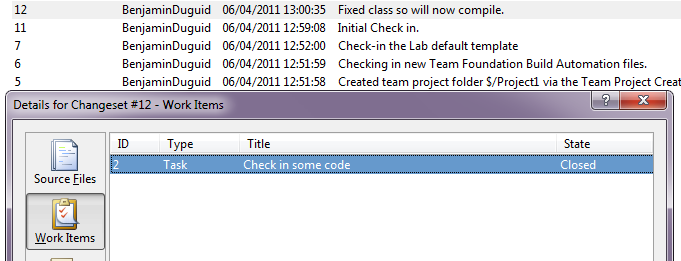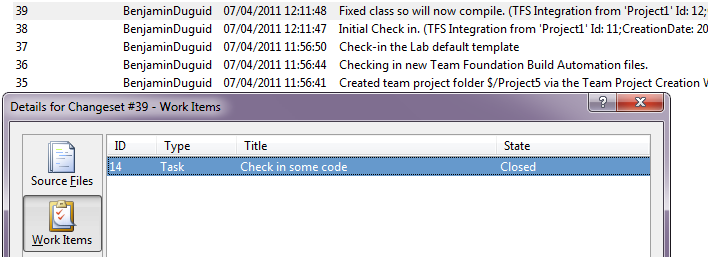Killing off TFS 2005: Part 2
Posted 07 April 2011, 13:10 | by Ben Duguid | Perma-link
Following on from where we left off in Part 1.
Recap
We've upgraded a copy of the Team Foundation Server 2005 databases to TFS 2010, and connected to it using Visual Studio 2010 to confirm I was happy that the source code, history and work items had indeed been migrated successfully.
I've also installed a copy of VS2003, and the latest version of the MSSCCI Provider to confirm that I'm happy with it in that scenario, as well as confirmed that users that aren't project administrators can also see the history, etc (we'd had issues with this on the VSS - TFS upgrade).
The full series
- Part 1: In which the scene is set.
- Part 2: In which the Hands on Labs are completed (this post).
- Part 3: Where we attempt the migration.
- Part 4: In which conclusions are drawn.
- Part 5: In which errors are noted.
Part 2: Merging Projects
Now comes the more complicated part: Merging the projects from the upgraded Team Project Collection (MissouriImported). This is made more complicated by the fact that I didn't come up with a sensible name for the new instance of a project in the original TFS 2010 instance (Newyork) - so I now have two projects with the same name in different collections that I'd like to have in the same collection, but with different names.
After I'd installed the TFS Integration Tools (note to self: When it asks for the database server, and defaults to a SQL Express instance, if you're connecting to the default SQL Server instance on a box, you don't want to add the instance name - so just TFS10 and not TFS10\MSSQLSERVER  ) I then tried going through the Getting Started with a TFS to TFS Migration Hands On Lab (HOL) that comes as part of the guidance - I strongly recommend that you do as well to familiarise yourself with the process, however it's not all plain sailing.
) I then tried going through the Getting Started with a TFS to TFS Migration Hands On Lab (HOL) that comes as part of the guidance - I strongly recommend that you do as well to familiarise yourself with the process, however it's not all plain sailing.
Running through the Hands On Lab
Basic Scenario
This worked out quite nicely, but then it's designed to minimise and work around all potential conflicts - as I'm not using the "Visual Studio ALM Rangers HOL base image" mentioned in step 4 of the HOL, I obviosuly had to set up some projects - this I did in much the same way the HOL described. Note that the HOL is a little out of date compared to the tools:
- When you configure the Version Control and Work Item Tracking sessions, the screen-shots imply that the name of each session is of the form "Project Name (ServerName)", but the tool appears to use "ServerName (Session Type)", so instead of getting "TP-A (tfs10)" I got "tfs10 (VC)" for both the Left and Right sources. You can (and probably should, especally if you're planning on doing a two-way sync) change these names to something more useful.
- When the HOL asks you to Save and Close you should Save to Database.
As I'm planing on running a "One-way migration" I skipped step 7.3, 7.5 & 7.4 [sic].
Advanced Scenario
This is where the issues really started. As I'm going to be importing into a project with the same team process, I wasn't too fussed about changing the WIT types, however it's good to read through it, as this is the easiest way to move projects to a different process template - something I may be doing at a later point for some of our old projects.
I basically hit an issue with the Version Control (VC) migration, in that the HOL assumes that the VC conflict you're going to see with the BuildProcessTemplates folders will result in the error "A content conflict has been detected…" with an option to use the "Always take the source system's changes" resolution, however this wasn't available to me, as the error I received was "A namespace conflict has been detected between the source and the target system…" which meant I had to provide "merged changesets for the source and target system (requires a manual merge)". This is rather tedious as the files themselves are identical when compared beyond their check-in timestamps, and I couldn't work out what it really wanted - providing some rather arbitrary changeset ids resulted in no source code at all being migrated.
In the end I worked around it by effectively ignoring the BuildProcessTemplates folder:
In the Version Control Session definition, I added a new Paths rule, set it to "Cloaked" for the BuildProcessTemplates paths:

With this rule in place, the duplicate BuildProcessTemplates folder and XAML files were ignored by the migration, and it completed smoothly.
As an example, here's the work items list for a check-in on Project1:

As you can hopefully see, this check-in has a comment, and is associated with a closed task work item (2).
Here's the equivalent for the migrated project:

This is associated with the migrated task (14), and the check-in comment has been carried across, and had the details of where it came from, along with the original check-in details (changeset ID and timestamp).
I'm therefore fairly optimistic now for the dry run of the main project migration, even though it's got over 3GB of "stuff" under source control (I use the word "Source" advisedly there, there's a lot of other things in there, from binaries to SDO packages and beyond).
I'll let you know how it goes.
Filed under: TFS